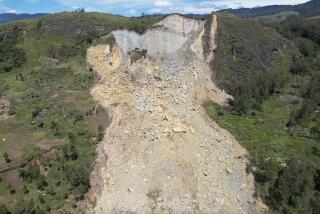Islanders Dig for Quake Victims
- Share via
JAKARTA, Indonesia — Residents of the remote Indonesian island of Nias pulled hundreds of bodies from the rubble Tuesday after a powerful earthquake off the coast of Sumatra that flattened buildings, collapsed bridges and damaged the airport runway.
Witnesses said the quake had collapsed all the buildings on the main street of Gunungsitoli, the island’s largest town. Desperate residents used crowbars and bare hands to move rubble in the hope of reaching trapped survivors. Some worked into the night by candlelight.
Emergency aid shipments began arriving from the nearby island of Sumatra, but officials said rescue efforts were slowed because many survivors had fled to higher ground fearing another earthquake and tsunami in the coming days.
“We have a lack of people to help pull the bodies from the debris because all of them want to save their family first and because there is a rumor that there will be another big earthquake that will be followed by a tsunami,” said Binahati Baeha, head of Nias district.
The magnitude 8.7 quake struck after 11 p.m. Monday. Officials estimate that it killed 1,000 to 2,000 people, most of them on Nias. The epicenter was about 75 miles from the island, known as a destination for surfers.
The neighboring island of Simeulue to the north also suffered considerable damage, and officials there reported between 15 and 100 dead.
On the nearby Banyak Islands, about 200 to 300 people were killed, wire services reported today. They quoted an aid official in the Sumatran city of Medan.
Detik.com, the online Indonesian news agency, reported that the region’s military commander and civilian governor said the earthquake had generated a tsunami with waves 6 to 10 feet high that struck Simeulue.
The news agency also reported that people on Sumatra said a 10-foot wave had hit at Singkil near the border of Aceh and North Sumatra provinces.
The reports could not be confirmed, and it was unclear whether the waves caused damage.
Many experts initially expected that Monday’s quake -- one of the largest on record in the last 100 years -- would trigger a tsunami similar to the one that struck the region Dec. 26, killing more than 175,000 people in 12 countries and leaving about 106,000 missing.
But wave gauges in several parts of the Indian Ocean measured only a slight bulge of 4 to 12 inches, which would have gone unnoticed by most people on the shore.
There was widespread evidence of the effect of the shaking. Arimitara Harefa, a resident of Nias who owns a seaside recreation park, estimated that as much as 80% of Gunungsitoli’s buildings were damaged or destroyed.
Many people were sleeping at the time of the quake and were crushed or trapped in their homes, he said. The temblor also set off fires that caused further damage.
“Nobody helped putting out the fires because everybody ran for safety,” Harefa said. “People ran to the hill. There is a rumor that there will be another big earthquake in the next four days, so people are cautious. People are so traumatized they will believe anything.”
Makeshift morgues were set up at mosques. Some men delivered bodies by motorbike.
The earthquake damaged roads around the 1,600-square-mile island and destroyed several bridges, isolating communities. Cracks in the island’s airstrip delayed the arrival of aid planes, but they began landing by Tuesday afternoon. The island’s water systems were also damaged.
Baeha, whose district makes up half the island of Nias and includes Gunungsitoli, said the towns of Teluk Dalam and Lahewa had been destroyed. He added that it would take days to confirm how many people had been killed.
With the post-tsunami relief effort continuing in Sumatra’s Aceh province, aid groups were quick to organize assistance for Nias and Simeulue.
Within hours of the earthquake, the United Nations sent in assessment and rescue teams and medical staff. Australia and Singapore, which recently pulled their troops from the effort in Aceh, redeployed their forces to the newly stricken area.
“We have no definitive figures on casualties,” said Masood Hyder, a U.N. official who was helping to coordinate the relief. “But they have already requested large quantities of tents, emergency food and facilities for medical evacuation.”
Dinda Jouhana of The Times’ Jakarta Bureau contributed to this report. Paddock reported from Kuta, Indonesia, and Sudarsono from Jakarta.
More to Read
Sign up for Essential California
The most important California stories and recommendations in your inbox every morning.
You may occasionally receive promotional content from the Los Angeles Times.












